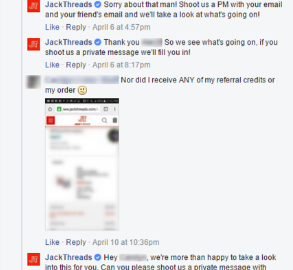
Despite the many benefits of using social media for business, brands still get a bit anxious about the potential for customers to use their social media channels as a platform to publicly blast every mistake made, essentially airing out all dirty laundry right in front of potential customers.
The fear is real. According to a study by VentureBeat, Americans write 2.5 million negative comments across social media platforms on a daily basis. Yet, despite the rationality behind the fear, brands should see negative comments as an opportunity rather than a threat, as they give you the chance to show your stuff (ie. how you work to solve problems). If you handle social media complaints correctly, you can actually come out looking better than you would if no problem had occurred whatsoever. In fact, according to Lee Resources, if you are proactive in solving customer service complaints, they will continue to do business with you 70% of the time.
So here are the best strategies for showing your problem solving skills on social media:
Don’t be Afraid to be Public, but Encourage Private Channels
You have nothing to hide–so don’t be afraid of addressing disputes in public when applicable. That being said, it is always best to try and move discussions to private channels in order to come up with the best solution to fit each specific problem.
Sometimes your customer’s issues are complex. Furthermore, he or she may not be interested in sharing the full extent of their experience for everyone to see. By moving to a private channel such as Facebook Messenger for Business, you become their one-on-one confidant, working with them to address each issue quickly and efficiently–without the fuss. Not only does this build trust, but it deepens the personal relationship between your brand and this customer, ultimately resulting in increased loyalty.
Respond in a Timely Manner
Customers expect a speedy response on social. So when they announce their dissatisfaction on Facebook or Twitter, the worst you can do is let it sit unanswered. According to Convince and Convert, 42% of consumers expect an answer to their social media complaints within an hour of posting. Customers become frustrated when their problems are not immediately addressed on social because it forces them to move outside their preferred channel to reach a solution. This hinders the overall customer experience and kills brand loyalty.
Remember that negative buzz spreads fast. So if you fail to address customer queries immediately, your audience may begin to suspect you have something to hide. Even if you don’t have a solution right away, make an effort to respond. Reassure them that you are aware of the problem and are doing everything in your power to find a solution. This way, they feel that you care about their issues and improving their experience.
To take it a step further, use a technology that allows you to resolve dilemmas inside a social channel. Such technologies provide a full customer profile (from integrated social platform and CRM) at your fingertips. This way, you never have to bring customers outside the social media channels they love in order to find solutions.

Be Human
Customers appreciate dealing with other humans as opposed to corporations. So try and speak to them in a way that’s natural, relatable, and down to earth by matching their tone. In other words, be sympathetic, not synthetic. Show empathy when addressing their complaints by acknowledging their frustration. This reveals you understand the seriousness of their issue and are willing to go to great lengths to solve it.
It also doesn’t hurt to be witty and use a bit of humor in your response. Customers appreciate this because it shows personality and makes you more relatable. To take the relatability to the next level, respond with your name and a profile picture. This way, you prove that there is an actual human behind the brand, making you appear more trustworthy and less robotic.

Acknowledge Mistakes and Apologize
Nobody is perfect. Thankfully, your customers understand that. They know they make mistakes and therefore, its likely for companies to as well. Confronting your mistakes makes you human, whereas denying them makes you kind of a jerk. So be transparent and formulate a formal apology.
In addition, doing so shows humility as well as a willingness to address the issue at hand. Never deny the problem or blame others. This can make you appear suspicious and unreliable, making them less inclined to want to work with you in the future.

Offer Resolution
At the end of the day, customers won’t be happy unless you offer viable solutions. So keep in touch with them every step of the way through their prefered channel and communicate the actions you are taking to solve their problem. If applicable, tell them you are sending someone over to deal with it directly or make it clear you are doing everything in your power to solve it quickly and effectively.
Lastly, offer incentives to show your appreciation for their loyalty so they feel valued and be sure to come up with a lasting solution to ensure the problem will never happen again.
Customer complaints can feel like a slap in the face. After all, you do the best you can to make sure your customers are happy at all times. However, with social media in the picture, you have the power to turn negative attention into a walking endorsement. Mistakes happen, but what matters the most to customers, is how you handle them. By communicating through social channels and using them to handle issues quickly and easily, you show your customers you value their time and their business. In the end, this makes your relationship stronger and more sophisticated than ever before.
Digital & Social Articles on Business 2 Community(33)







